When you buy through our links, we may earn an affiliate commission.
Don’t let their size fool you. Parlor guitars are actually pretty awesome.
Initially used in the early 1900s by musicians performing in smaller venues, parlor guitars are regaining their popularity among blues players, folk artists, singer-songwriters, recording engineers, and even beginner guitarists.
Their size makes playability and transportation a breeze, and they have a great tone that can cut through the mix.
Our top pick is the Yamaha CSF3M for its resonant tones, excellent craftsmanship, and affordable price.
Let’s take a look at some of the best parlor guitars!
Quick Summary of the Best Parlor Guitars
- Yamaha CSF3M (Our Top Pick)
- Gretsch G9500 Jim Dandy (Budget Pick)
- Guild M-20 (Premium Choice)
- PRS SE P20E Parlor (Best Value)
- Takamine GY93E New Yorker (Best Under $1000)
- Ibanez PN12E (Best Under $200)
- Epiphone L-00 (Best Under $500)
- Yamaha CSF-TA (Best for Built-In Effects)
- Cordoba C9 Parlor (Best Classic Parlor Acoustic Guitar)
- Gibson Acoustic L-00 (Best for a Big Budget)
Best Parlor Guitars
1. Our Top Pick – Yamaha CSF3M
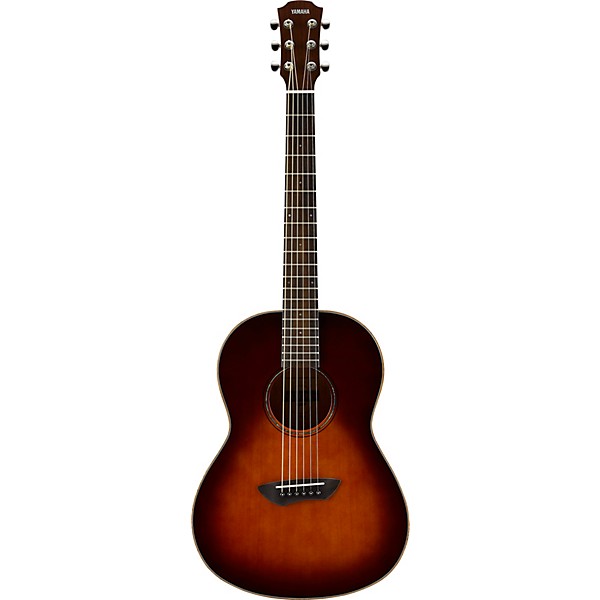
SPECS
- Body: Solid Sitka Spruce Top, Solid Mahogany Sides & Back
- Neck: Nato
- Fingerboard: Rosewood
- Frets: 20
The name Yamaha has long been synonymous with excellent quality instruments, and the Yamaha CSF3M is no exception.
The CSF3M is a high-end parlor guitar made with top-quality woods that give it a down-to-earth yet elegant vintage aesthetic.
Its solid Sitka spruce top offers a robust projection and a beautiful tone, while its solid mahogany back and sides add a layer of low-end warmth for great tonal balance.
It also boasts a passive SRT Zero-Impact piezo pickup for a stunning amplified acoustic tone. Its scalloped x-bracing gives the CSF3M a surprising amount of mid to low-end response—that is, in addition to its already pristine high-end.
This parlor guitar’s sound is crisp, clear, and open, with a rich and resonant tone that can easily cut through the mix to make it heard. You’ll be hard-pressed to find a parlor guitar at this price range that offers impeccable features and gorgeous performance.
Interested in Buying a Guitar Stand? See Some of Our Favorite Guitar Stands for Bass Guitars
2. Budget Pick – Gretsch G9500 Jim Dandy

SPECS
- Body: Basswood Top, Sides & Back
- Neck: Nato
- Fingerboard: Walnut
- Frets: 18
Faithful to the Gretsch “Rex” parlor guitars of the 1930s, ‘40s, and ‘50s, the G9500 Jim Dandy Flat Top parlor-style model embodies everything that was great about everyone’s first parlor guitar.
The Gretsch Jim Dandy is perfect for both picked and fingerstyle playing and features a non-cutaway basswood body with X-bracing for a powerful and resonant voice.
Its highly resonant basswood back, sides, and top, along with an elongated body, give the G9500 with plenty of natural projection.
It might not pack quite the punch that other parlor guitars in this list do, but this is still one of the best parlor guitars from one of the best guitar makers in the business.
The G9500’s vintage look is absolutely stunning and will be the center of attention in any intimate setting or small venue.
Ideal for songwriting, practice, or even as a travel guitar, this little wonder is great for beginners and seasoned pros alike. Comfortable to play and full of woody vintage tones with full-sounding bass, the Jim Dandy will inspire hours of playing a joy.
3. Premium Choice – Guild M-20
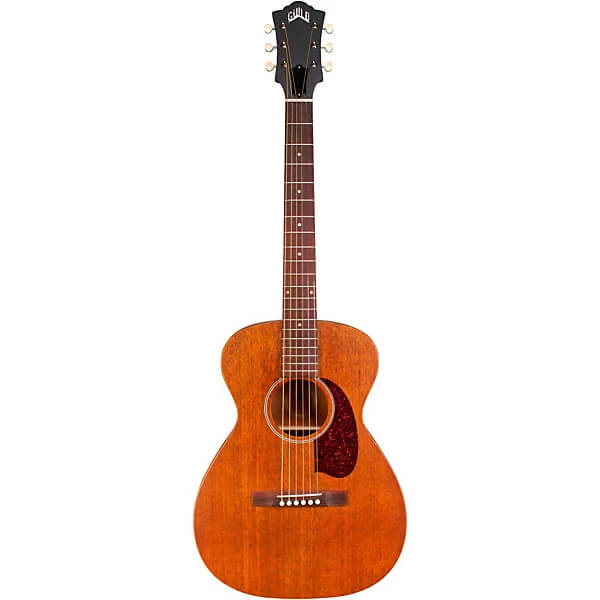
SPECS
- Body: Solid Mahogany Top, Sides & Back
- Neck: Mahogany
- Fingerboard: Rosewood
- Frets: 20
Guild’s iconic M-20 was the first guitar off the production line in 1967 in Westerly, Rhode Island. Over 50 years later, the new M-20 offers the stunning vintage look and tone that made the original so popular.
The M-20 is exquisitely crafted with a solid mahogany body, neck, back, and sides, a tonewood that specializes in warmth and clarity and emphasizes middle frequencies. It also features a rosewood fingerboard and fingerboard that enhance the guitar’s harmonic overtones.
Finally, its bone nut and saddle and an extremely light satin finish allow the M-20 guitar to sing loud and clear.
There’s also the option to get the guitar equipped with a piezo pickup system from LR Baggs right at Guild’s facility—just remember to have an acoustic amp handy if you go for this choice!
This guitar might be on the expensive end of the spectrum, but there's no doubt it's the best parlor guitar money can buy.
4. Best Value – PRS SE P20E Parlor

SPECS
- Body: Solid Mahogany Top, Mahogany Sides & Back
- Neck: Mahogany
- Fingerboard: Ebony
- Frets: 20
The PRS SE P20E is a small parlor acoustic guitar with a big voice. This professional-grade guitar is packed with incredible features that ensure you’re getting more than your money’s worth.
The P20E’s solid mahogany body, laminated mahogany neck and sides, and mahogany neck give it a rich, smooth, and warm voice. A bound ebony fingerboard gives the neck a smooth feel and rich tones.
Featuring PRS hybrid “X”/Classical bracing, which allows the top to vibrate freely, the SE P20E projects an even, bold tone.
Plug in, and the Fishman GT1 pickup system delivers a dynamic, organic tone. So, whether you’re writing, recording, or performing, the P20E will go above and beyond what you would expect from a parlor-sized guitar.
The P20E is an excellent parlor guitar that is a great choice for beginners due to its manageable size and great features, but it would be equally at home in a veteran player’s acoustic collection.
5. Best Under $1000 – Takamine GY93E New Yorker
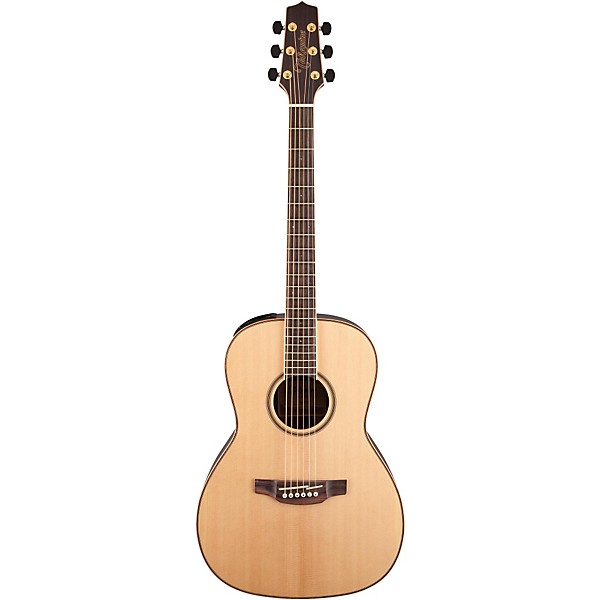
SPECS
- Body: Solid Spruce Top, Black Walnut/Maple Sides & Back
- Neck: Mahogany
- Fingerboard: Laurel
- Frets: 20
Takamine has been designing and building acoustic guitars for decades, and the GY93E New Yorker benefits from all these years of experience, the use of the finest tonewoods, and expert construction techniques.
Featuring Takamine’s parlor-style New Yorker body, the petite GY93E electro-acoustic guitar offers a solid top and distinctive back construction, giving it an upscale feel and distinctive sound.
With a highly resonant solid spruce top, scalloped X-bracing, black walnut sides, and 3-piece black walnut/maple back, this parlor guitar is tonally versatile and provides incredible volume and projection.
The slim mahogany neck and 12”-radius bound laurel fingerboard provide a great feel and playability.
Additionally, the onboard Takamine TK-40D preamp system gives you a built-in tuner, three-band EQ and gain controls, mid-contour switch, notch filter, and EQ bypass switch for the ultimate versatility and sound quality.
6. Best Under $200 – Ibanez PN12E
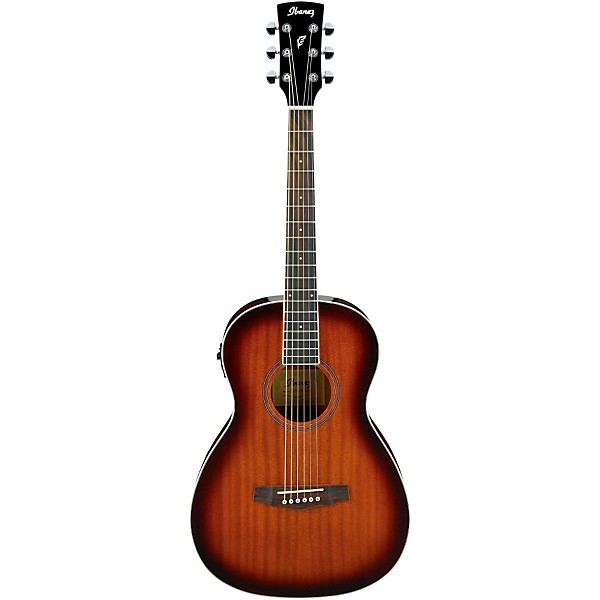
SPECS
- Body: Sapele Top, Nyatoh Sides & Back
- Neck: Nyatoh
- Fingerboard: Nandu
- Frets: 18
The Ibanez PN12E is made with a combination of woods that hasn’t been featured in this list yet: sapele, nyatoh, and nandu. These tonewoods are native to South East Asia and can be easily sourced locally in Indonesia, helping Ibanez to keep manufacturing costs low.
The most notable feature of the PN12E is the tone. Its sapele top and nyatoh back and sides exude a warm and balanced tone that sounds lovely at home, in the studio, or in a small venue.
This small guitar also features an AEQ-2T preamp specifically designed to adjust the frequencies of bass and treble and allows the operation of the built-in tuner without the instrument being plugged in.
This budget-friendly parlor guitar has a great-quality build for the price; it looks classy and offers great sound and playability.
7. Best Under $500 – Epiphone L-00

SPECS
- Body: Solid Spruce Top, Mahogany Sides & Back
- Neck: Mahogany
- Fingerboard: Indian Laurel
- Frets: 19
The Epiphone L-00 acoustic-electric guitar is a direct descendent of Epiphone’s original line of flattops going back to the golden age of acoustic guitars in the 1930s. It is also the budget-friendly alternative to the Gibson L-00, which we'll discuss later in this list.
This quality parlor guitar—or "blues box," as they were also known—is perfect for any setting, but it is particularly great for recording sessions.
The L-00 has been favored by blues players of all eras for its compressed, woody tonal quality, short scale, and comfortable weight, which makes it ideal for fingerpicking and light strumming alike.
Now featuring the Fishman Sonitone soundhole preamp and Fishman Sonicore pickup, the L-00 can be plugged in whenever you need to, making it the perfect accompaniment for singer-songwriters.
The pickup is fitted right under the mouth of the soundhole and lets you adjust the master volume as well as tone, further giving you control over your own sound.
8. Best for Built-In Effects – Yamaha CSF-TA

SPECS
- Body: Sitka Spruce Top, Mahogany Sides & Back
- Neck: Nato
- Fingerboard: Rosewood
- Frets: 20
The Yamaha CSF-TA is not your typical acoustic guitar. Many consider this impressive instrument to be the perfect parlor guitar and for a good reason.
It implements Yamaha’s groundbreaking TransAcoustic technology, which delivers mind-bending onboard reverb and chorus effects.
The way TransAcoustic technology works is via a small device called an actuator, which is hidden inside the guitar. When you play, and the guitar vibrates, the strings cause the actuator to vibrate as well. These vibrations are transmitted to the guitar body, as well as to the air around the guitar.
The result is authentic reverb and chorus without the need for any additional amplification or effects—this is what truly sets TransAcoustic guitars apart from other instruments with onboard effects.
The CSF-TA also features a mahogany back and sides, a solid Sitka spruce top, and a smooth nato neck and rosewood fingerboard, which work together to create a truly beautiful and mellow tone.
The CSF-TA’s System70 + SRT piezo pickup system can access those mind-blowing tones when it is time to plug in your guitar.
9. Best Classic Parlor Acoustic Guitar – Cordoba C9 Parlor

SPECS
- Body: Solid Canadian Cedar Top, Solid Mahogany Sides & Back
- Neck: Mahogany
- Fingerboard: Rosewood
- Frets: 19
The handmade C9 Parlor is ideal for guitarists looking for the comfort and ease of playability that a smaller instrument provides while retaining the sweet, warm tone created by all-solid wood construction and unsurpassed craftsmanship.
The C9 Parlor features solid mahogany back and sides with a solid Canadian cedar top that offers rich tones with a lively presence. Its solid mahogany neck also provides excellent sustain.
C9 parlor acoustic guitars have a Spanish heel construction style and bracing style that showcase the masterful techniques that Cordoba is known for, giving us a beautiful instrument with a stunning sound.
The C9 Parlor is a fully acoustic guitar, which means you won’t be able to plug it in. But if you don’t need electronics in your parlor guitar, then the C9 is a great option.
The solid wood construction, the bracing, and the bone saddle and nut all contribute to making this parlor guitar louder and more resonant.
This nylon string parlor guitar is the best classical guitar in the market today.
10. Best for a Big Budget – Gibson Acoustic L-00
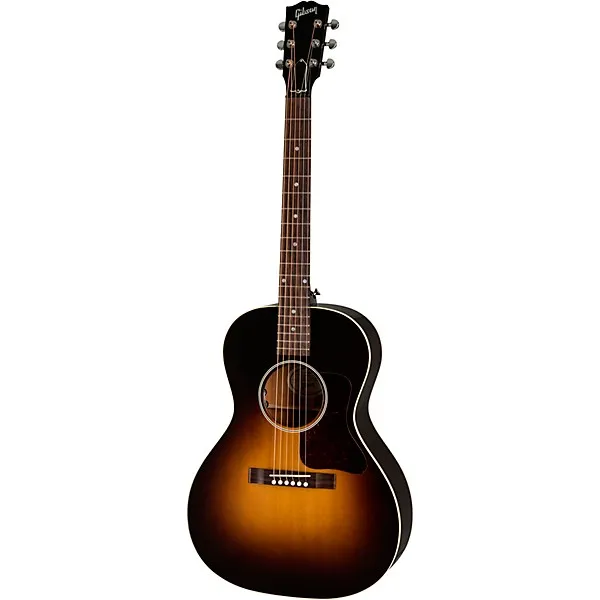
SPECS
- Body: Sitka Spruce Top, Mahogany Sides & Back
- Neck: Mahogany
- Fingerboard: Rosewood
- Frets: 19
The Gibson Acoustic L-00 may not be an affordable parlor guitar for many, but we’d be remiss if we didn’t recognize it as one of the best parlor guitars on the market.
Developed in the ’30s, the L-00 set an industry standard. Nowadays, it beautifully captures the heritage of those exemplary early models with perfect balance and unparalleled projection.
Built from top-shelf tonewoods, the L-00 is a perfect combination of punchiness, mid-forward projection, and harmonic overtones. This guitar's tone is dynamic and lends itself to fingerpicking and heavy strumming alike.
Finally, the L-00 comes with LR Baggs VTC acoustic pickup system, which features a low-profile under-saddle transducer that is incredibly stable and durable and offers an unparalleled amplified tone.
All in all, we could even go as far as to say that the L-00 is a dream parlor guitar that will not disappoint.
Best Parlor Guitars Buyer's Guide
What Is a Parlor Guitar?
The parlor guitar is a small-bodied guitar that musicians would use in the late 1800s and early 1900s for intimate performances in small venues, such as bars or parlors—where the instrument got its name.
Although there is no exact definition for what makes a parlor guitar, the term is generally accepted to mean a small-bodied acoustic guitar that is narrower than current standards.
More specifically, parlor guitars are smaller than Martin & Co’s size 0 concert guitars.
What You Should Look for When Purchasing a Parlor Guitar
Size and Shape
When it comes to parlor guitars, there is no standard shape or size used by all guitar makers, which means there will be a few shapes and sizes available for you to choose from.
Parlor guitars are characterized by having a narrower shape and shorter scale length than most acoustic guitars, which makes them more comfortable to play, especially for people with smaller bodies.
Make sure to try out several models to check that the guitar’s body sits in a comfortable position so there’s no strain while you’re playing.
Wood
The woods a parlor guitar is made of have a big effect on the sound it creates. If your budget allows, try going for guitars made from solid wood instead of wood laminates or other substitute textiles.
The latter may be initially cheaper, but they don’t have the same durability as higher quality woods, so you may end up investing more in having it repaired or replacing it altogether.
The most commonly used woods for a parlor guitar’s top, body, neck, and back are Spruce, Mahogany, Cedar, or Agathis, while the fingerboards are typically made with Rosewood or Walnut.
Each of these woods has its own unique tone and sound quality, from bright, clear, and crisp, to rich, deep, and dark.
Tone
Speaking of tone, parlor guitars have a very distinct sound, being generally brighter, clearer, and more defined due to their smaller body size.
They produce a clear mid-range tone that is great for cutting through a mix and can shine beautifully in acoustic guitar recordings.
This unique tone works great in many different genres and historically has been used for blues, indie, and folk music.
Frequently Asked Questions (FAQs)
Are parlor guitars easier to play?
Yes, parlor guitars are easier to play than regular acoustic guitars because of their short scale length, smaller size, and narrower shape.
The short scale length means the strings hold less tension, making the parlor guitar easier to fret and bend. This is also why parlor guitars can be great for both fingerpicking and strumming.
Are parlor guitars good for beginners?
All the features mentioned above make parlor guitars an excellent choice for beginners to start learning the guitar. In particular, they can be a great starting point for children, young players, and people with smaller hands.
Are parlor guitars the same as travel guitars?
There are a few subtle yet crucial differences between parlor guitars and travel guitars.
First, parlor guitars normally have 18 frets, which is less than the 21 to 24 frets travel guitars usually have.
Second, travel guitars are shaped like regular acoustic guitars, the only difference being that they’re smaller in size. Meanwhile, parlor guitars are longer and narrower in comparison to acoustic guitars.
Finally, travel guitars have a smaller nut width than standard acoustic, while parlor guitars have the same nut width as regular-sized acoustic guitars.
Should I get a parlor guitar with electronics?
This depends on what use you want to give to your parlor guitar.
If you want it for gigs, busking, or recording directly into an audio interface, then a parlor guitar with a built-in pickup is the way to go. The good news is that most parlor guitars offer built-in electronics.
Some electro-acoustic parlor guitars also have controls on the side for volume and maybe even a simple EQ, which is something not all parlor guitars offer.
If this doesn’t match your needs—say, if you only want your guitar to practice or for playing at home—then a pickup won’t be necessary and you can just go for a regular acoustic parlor guitar.
Why should I buy a parlor guitar?
Not only are parlor guitars beautiful instruments with a stunning vintage vibe, but their unique resonant tone makes them a joy to play.
If you’re a beginner looking for your first guitar or a seasoned player who wants a great instrument for an intimate performance, then parlor guitars are worth looking into.
Electro-acoustic parlor guitars are also a wonderful option for small gig settings such as busking, bars, coffee shops, or theaters.
Who is this guitar not for?
More seasoned acoustic guitar players who are used to larger-bodied guitars might find it difficult to get used to the small, narrow body of a parlor guitar.
Additionally, if you want a guitar for large gigs and bigger crowds, a parlor guitar might not be the right choice for you, and it might be better to look into other acoustic guitars.
Conclusion
Despite their smaller size, parlor guitars are beautiful and powerful instruments that can be enjoyed at home, in intimate gig venues, or in recording studios.
Our absolute favorite parlor guitar is the Yamaha CSF3M because it offers a lovely resonant tone and Yamaha’s high-quality craftsmanship at a great price.
If you want a more affordable option, the Gretsch G9500 is absolutely gorgeous, has a powerful tone, and is incredibly comfortable to play.
We hope this guide has helped you come closer to deciding which is the right parlor guitar for you!
